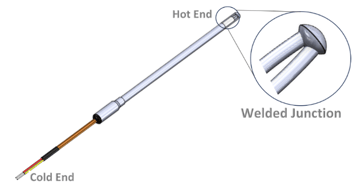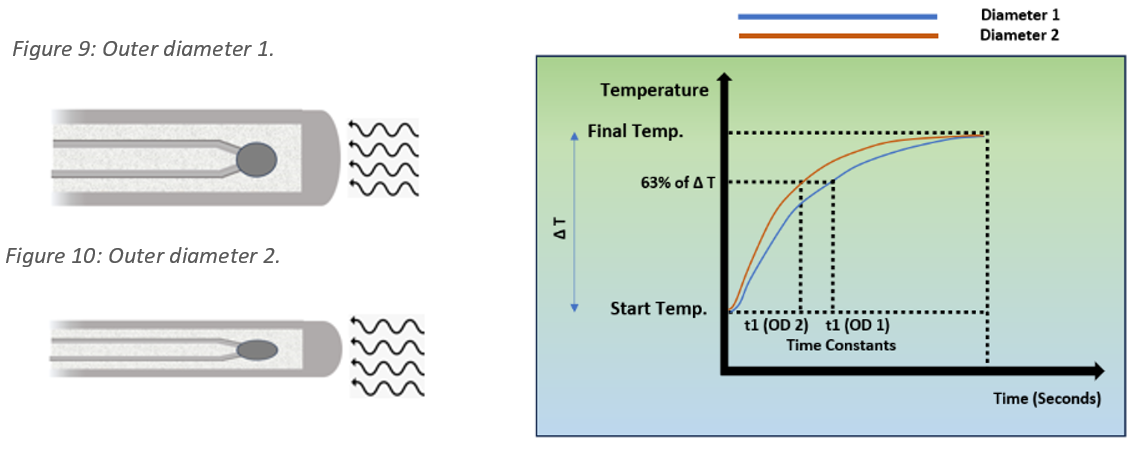
By:
Dave Dlugos
Product Technical Leader
Published on:
September 26th, 2024
Subscribe now and get the latest blog posts delivered straight to your inbox.
Grounded vs. Ungrounded Thermocouple Junctions: Why Select One over the Other?

By:
Dave Dlugos
Product Technical Leader
Published on:
September 26th, 2024

This article was originally published on December 4, 2023, by Rick Zerafin and updated on September 26, 2024.
If your work involves critical applications with harsh conditions, extreme weather and high-vibration environments, thermocouples are essential instruments that can keep your system operating efficiently. They are often used in equipment like turbine systems, gas compressors, pumps and other equipment to provide clear and reliable signals to communicate whether a system is working properly, or not. In doing so, these instruments help reduce downtime, lower maintenance costs and increase productivity.
Selecting the correct junction type is critical to ensure optimal temperature sensor performance. With 40 years of measurement instrument experience, I am often asked about the differences and benefits of each junction option.
In this article, you will learn about the different thermocouple components, including two of the most common types of junctions: grounded and ungrounded. You will also learn the advantages of each junction type, and which is preferable for different applications. When you are done reading, you will have a clear understanding of the best junction to select for your specific needs.
Basic components of a thermocouple.
Industrial thermocouples like the Ashcroft® S50 and S80 have two alloy conductors that are made from different alloys and welded to form a junction. The hot end, which is also known as the heat source, is always immersed in the temperature measurement area. The cold end, also known as the cold junction, is always in the ambient location where the sensor wires are terminated and serves as the reference point for measuring the temperature gradient between the hot and cold ends.
Figure 1: Thermocouple hot end and cold end.

How thermocouples work.
Thermocouples measure the temperature gradient between the cold end junction and hot end junction. Based on the temperature difference between both junctions, the thermocouple circuit generates a millivolt signal. The higher the temperature difference the higher the sensor’s millivolt signal output.
Cold junction compensation complements the millivolt signal to generate the actual hot end temperature measurement. These millivolt signals are small. For example, a type K thermocouple with a temperature gradient of 100 degrees generates only 4.096 millivolts.
The small millivolt signal means care must be taken to select the correct thermocouple junction type to maintain signal integrity and reliability.
Grounded thermocouple junctions.
To form a grounded thermocouple junction, the conductor alloy weld bead is positioned in direct contact with the sensor’s outer protective metal sheath.
Figure 2: Grounded thermocouple junction.

This direct contact creates a seamless connection between the sensing element and the protective sheath, ensuring that the heat from the process is efficiently transferred to the sensor.
This option has several advantages:
Enhanced precision in temperature measurement.
Direct contact with the outer sheath means minimal thermal resistance and a more precise measurement. This makes making grounded sensors the preferred configuration for surface temperature applications. For example:
- Fired heaters that depend on precision measurements of process tube surfaces
- Furnace teams who use it to support decoking schedule calculations
Faster temperature measurement time response.
Grounded junctions are ideal for safety applications needing quick temperature detection. For instance, time-sensitive control loops with final elements such as valves, pumps and heaters depend on fast time responses from all instrumentation including temperature sensors.
Direct contact between the alloy junction and outer sheath shortens the heat transfer path, leading to a faster response time compared to an ungrounded junction.
Figure 3. Grounded thermocouple junction with heat transfer.
Grounded thermocouple junction challenges.
Grounded junctions are widely used in various applications, but they come with noise and expansion issues that impact the small millivolt signal.
Noise interference.
Ground loops and stray currents from sources like welding can cause noise in the thermocouple's signal.
Figure 4. Grounded junction with heat transfer. Figure 5. Noise interference.

Expansion coefficients and grain growth.
Stress from outer sheath expansion can cause grain growth in conductors, leading to intermediate signals and eventual thermocouple failure.
Figure 6: Conductor separation. Figure 7: Intermittent signal.

Ungrounded thermocouple junctions.
Ungrounded thermocouple junctions are created by isolating the weld bead junction from the outer sheath following ASTM and IEC Standards.
Figure 8: Ungrounded thermocouple junction.

This type of thermocouple junchtion also offers advantages for certain applications:
Signal integrity.
Choosing an ungrounded thermocouple with mineral insulation such as MgO (Magnesium Oxide) prevents ground loops and isolates the sensor from noise. While loop signal isolators and transmitters help, a mineral-insulated ungrounded thermocouple is the best method to isolate the sensor circuit.
Insulation resistance quality inspection.
Undergrounded thermocouples also allow inspection of the insulation resistance between the outer sheath and the thermocouple circuit. This is important because a common source of failure of thermocouples is moisture ingress into the mineral-insulated cable. Insulation resistance inspection is not possible with a grounded thermocouple.
Alloy conductor chemical protection.
Isolating the alloy conductors entirely from the outer sheath offers chemical protection to the entire sensor circuit. This is particularly beneficial at higher temperatures, where high-energy input can push impurities toward the alloy conductors.
Time response improvements.
To improve the response time of an ungrounded thermocouple, you can reduce the sheath's outer diameter. In turbine applications, the sensor tip can be made smaller to reduce its mass and increase strength.

Both types of junctions come with metal sheath sensors and mineral insulation around the conductors. The most common insulators are made from Magnesium Oxide (MgO), with Aluminum Oxide (Al2O3) being another popular choice. Depending on what you need, both grounded and ungrounded junctions have their own set of benefits.
Figure 11: Grounded vs. ungrounded advantathermocouple ges.

Which thermocouple junction will you choose?
Knowing the differences between grounded and ungrounded junctions and how they work with thermocouples provides a good foundation for answering that question. However, you may want to know more. Our Tech Team is on hand to address any additional inquiries that come up. Feel free to reach out to our specialists anytime.
In the meantime, download our guide for more information on how to find the right temperature and pressure instrumentation for harsh applications.
If you want to learn more about thermocouples and other temperature sensors, check out some of our other blog posts:
Dave Dlugos, Product Technical Leader
Dave Dlugos has a BSEE degree and 40 years of experience in the measurement industry performing design engineering and product management. He has earned 4 U.S. patents and joined Ashcroft in 2007, currently as the Product Technical Leader. He is a senior member of the International Society of Automation (ISA), past ISA District 1, Vice President, past ISA water and wastewater division board member and the past President of CT Valley ISA Section.


























